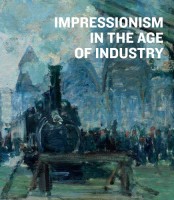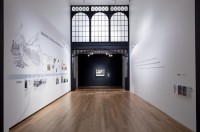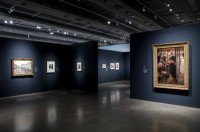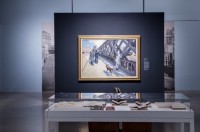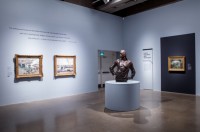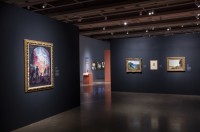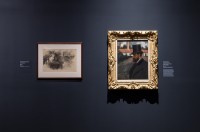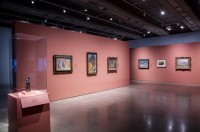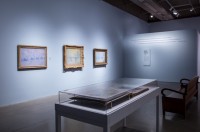The browser will either open the file, download it, or display a dialog.
Impressionism in the Age of Industry: Monet, Pissarro and More
Art Gallery of Ontario, Toronto
February 16–May 5, 2019
Catalogue:
Caroline Shields et al.,
Impressionism in the Age of Industry.
Toronto: Art Gallery of Ontario; New York: DelMonico Books-Prestel, 2019.
248 pp.; 100 color illus.; full checklist.
Available in English.
$50 (USD)
ISBN: 978-3791358451
On my second pass through the Art Gallery of Ontario’s excellent Impressionism in the Age of Industry: Monet, Pissarro and More, I overheard a visitor telling his companions, “generally speaking, [the exhibition] doesn’t have the typical Impressionist paintings you see—you know, the very pretty ones.” Though we may debate the contention that Claude Monet’s Arrival of the Normandy Train, Gare Saint-Lazare (1877) and Gustave Caillebotte’s The Seine at Argenteuil (ca. 1892) are not “pretty” pictures, the man’s observation was nevertheless a sign of the success of the show. Indeed, as curator Caroline Shields noted, the goal of the AGO’s exhibition and the accompanying catalogue, Impressionism in the Age of Industry was to shift the public’s perception of Impressionism as “a movement chiefly concerned with sunny landscapes, bourgeois leisure, and recreation,” to one that encouraged audiences to see the fundamentality of industry to the Impressionist project.[1]
On view from February 16 to May 5, 2019, Impressionism in the Age of Industry brought together painting, photography, early film, books, and sculpture in a thoughtful consideration of (mostly) French art at the end of the nineteenth century. Shields, the AGO’s Associate Curator and Head of European Art, conceived and organized the project in fourteen months, bringing together eighty-eight loans from domestic and international museums as well as private collections to complement thirty-two artworks from the AGO’s own holdings. Despite the show’s titular reference to Impressionism, the installation actually offered a far broader treatment of fin-de-siècle art with myriad works characteristic of different aesthetics. The objects attest to artists’ robust attention to the Second Industrial Revolution, highlighting their diverse approaches to engage with industrialization’s impact on urban and rural environments, questions of labor, gender norms, and more.
As with many projects at the AGO, Impressionism in the Age of Industry made its commitment to the viewer’s experience clear from the outset. Once visitors passed through the ticket stand—this exhibition was the last at the AGO for which there was a required surcharge on top of standard museum admission—they entered a long corridor with an extensive timeline. A theatrical train station backdrop composed of an archway capped by three-arched windows (constructed by a stage-set company) dominated the far end of the corridor, which bubbled with the background noise of French train-station announcements. At the end of the entrance hall, Claude Monet’s Arrival of the Normandy Train, Gare Saint-Lazare hung alone, majestically (fig. 1).
The combination in this foyer space was visually pleasing, especially in the quiet hours before the museum was open to the public. The timeline was eminently useful, highlighting the intersections of art, industry, and culture in France between 1853—when Baron Georges Haussmann became Prefect of the Seine—and the World’s Fair of 1900. This contextual information struck an appropriate balance between broad, overarching themes and niche facts—such as the date in 1884 when Eugène Poubelle mandated that apartment buildings have covered trashcans. The mock-station architecture was a charming detail and, when the number of visitors permitted it, Monet’s canvas appeared tantalizingly in the distance as the ultimate expression of beauty and innovation in the industrial age.
The feeling in this opening foyer changed according to the time and day. At mid-day on a Tuesday, for instance, the area felt compressed as it bustled in a manner that could evoke rush hour travel. As school groups and other museumgoers filled the entry space, the majority of visitors stood perpendicular to the back wall, reading the informative text before quickly walking over to see Monet’s painting. Others went directly to the canvas at the end of the hall before doubling back for the history lesson. This movement created a to-and-fro sensation that seemed entirely appropriate to the subject matter at hand and at odds with the typically reverent environments encouraged by conventional displays of Impressionist paintings.
The main galleries of Impressionism in the Age of Industry were divided into seven distinct sections—all consistently beautiful—as well as two spaces dedicated to interpretive materials and audience engagement. Upon entering the first space, visitors came face to face with James Tissot’s Shop Girl (1883–85), revivified by its new period frame. Hanging directly across from the entrance, Tissot’s protagonist looked out to the viewers, metaphorically opening the door for them to enter “The New Paris,” the subject of the first thematic section. Approximately twenty paintings, prints, and photographs join Tissot’s masterpiece in this initial portion, where the AGO’s design team used dark colors, low light levels and several temporary walls to break up the space (fig. 2).
This installation introduced viewers to the narrative of Haussmannization, a subject well known to students of French art and French history. The nuanced choice of objects was engaging both for non-specialists just learning about the rebuilding of Paris, as well as for more knowledgeable viewers, who could consider rarely seen juxtapositions. For example, the side-by-side exhibition of Camille Pissarro’s expansive Place du Théâtre Français, Paris: Rain (1899) and Charles Marville’s claustrophobic Rue de l’Anglade (1865–68) revealed both the physical changes of a single Parisian location as well as the way in which Impressionism conveyed the new experience of the French capital just one generation later. The duo, which cleverly juxtaposed the borrowed Pissarro with a photograph in the museum’s collection, is one that would make a great comparison for the opening of a lecture on fin-de-siècle Paris. It highlights not just social and geographic changes but also the developments of modern art and the relationship of painting to photography.
These opening galleries also included a number of works that examined the impact of the Franco-Prussian War and the Paris Commune on urban infrastructure. There was an unfortunate tendency to collapse the two calamities into a single disaster, therefore muddling the distinct impacts of each. On the other hand, enfolding the post-1871 rebuilding into a broader narrative of fin-de-siècle urbanization offered a legitimate alternative perspective. To these ends, the juxtaposition of Giuseppe de Nittis La Place des Pyramides (1875), which shows Emmanuel Frémiet’s Joan of Arc statue in the foreground and a scaffold-covered Louvre in the background, with Georges Seurat’s nearby Eiffel Tower (1889) revealed key tensions that permeated the era; in the 1870s and 1880s many French people vacillated between a desire to maintain traditions—as in De Nittis’ Salon-style work with markers of French constancy—and the impulse to embrace the destabilizing effects of industrial modernity, captured in Seurat’s Neo-Impressionist depiction of the now-iconic structure.
The dim lighting and warren-like feel that defined the spaces of the first few galleries gave way to a bright and expansive second section that explored trains and train stations as “modernity’s most potent symbol of progress.”[2] This area was one of the exhibition’s most successful moments of mixing painting, photography, books, and film. Camille Pissarro’s etching The Railway Bridge at Pontoise (1882) anticipated a later photograph of The Viaduc de Laval (ca. 1890–1900) by an unknown photographer. Perhaps most strikingly, the installation of the Lumière brothers’ 1895 film, Arrival of a Train at La Ciotat I, and Georges d’Espagnat’s 1896–97 painting, A Suburban Railway Station, made a strong case that the painter borrowed a motif from the earlier film.
This section of the exhibition also included an important series of photographs by Achille Quinet, Edouard Baldus, and Auguste-Hippolyte Collard. The works reveal the role of these artists and their peers in documenting the construction of railways, often as a result of both public and private commissions. Quinet’s photograph of the Gare de Strasbourg (1870 or before) shows the magnificence of the urban industrial monument while Collard’s Head of the Underground Cornu, Near L’Abresle (July 1866) and Villars Station (1865) relocate the discourse of train station construction from the urban sphere to the rural environment. More than simply emphasizing the impact of the train for linking various parts of the nation—a point the exhibition accentuated with the inclusion of the AGO’s Eugène Boudin’s A Beach at Trouville (1864)—Collard’s images show the impact of industrialism on an otherwise pristine landscape. This grouping of photographs, which foreshadowed a later group of paintings that show smokestacks in the landscape, served as a stark reminder of humans’ role in changing the climate. Though this was not the main point of the show, this theme could have been explored further through didactic materials, interactive tools, or public programing.
Gustave Caillebotte’s Le Pont de l’Europe (1876) was undoubtedly the centerpiece of the train section, and it hung on a temporary wall set back in the center of the gallery (fig. 3). In and of itself, the painting is continually rewarding, encouraging deep looking to reveal the complexities of the industrialized city and its populace, as well as shifting ideas about class and gender. The AGO took advantage of the work’s presence in the exhibition to introduce some ingenious interpretive materials. In an area behind the painting, the museum provided iPads that demonstrated how Caillebotte married three different viewpoints to best accentuate the long urban vista, the railway overlook, and the new Haussmann-style buildings in the background. The AGO credited the Swiss neuroscientist Claude Ghez for this interpretation, but the education team at the museum should also be praised for this use of technology. In addition to the “wow factor” of the augmented reality tool, the digital component (as well as an adjacent video screen with a PowerPoint-style presentation) was an effective way to understand the urban infrastructure of Caillebotte’s work and gave visitors a strong model to think about perspectives more broadly.
The third section of the exhibition moved visitors from train stations to ports, highlighting the role of waterways in the industrialization of fin-de-siècle France. This section, which was slightly smaller than the previous two, allowed Shields to explore what she described as the Impressionists’ effort to blend “gritty subject matter” with their “poeticizing impulse.”[3] Many works across this gallery, including Armand Guillaumin’s The Bridge of the Archbishop and the Apse of Notre Dame (ca. 1880), made the industrial components of smokestacks and tugboats secondary to the play of dappled colors on waterways and against the sky.
Hanging against the long wall of this section, Claude Monet’s The Coalmen (ca. 1875), on loan from the Musée d’Orsay, was one of the exhibition’s key paintings. The work, which is also the cover image of James Rubin’s 2008 book Impressionism and the Modern Landscape: Productivity, Technology, and Urbanization from Manet to Van Gogh, is a prime example of Monet applying his Impressionist technique to an industrial subject. As his brushwork captures the fleeting and ephemeral qualities of light, the industrial subject matter seems to have led Monet to emphasize pictorial structure and compositional rhythms. The arch of a transit bridge frames the horizontal scene while the vertical masts of the coal boats rise upward. Anonymous workers move in regularized, subdued motion as they complete an endless task of ferrying coal to shore in large wooden baskets.
Near Monet’s painting, Shields juxtaposed two 1896 paintings of Rouen by Pissarro, taking advantage of the great depth of the AGO’s collection and its power to secure important loans. Reunited here, the museum’s The Pont Boieldieu, Rouen, Damp Weather (1896) and the Carnegie Museum of Art’s The Great Bridge, Rouen (1896) show Pissarro considering the same subject from different points of view. Given the thematic emphasis of the exhibition, the inclusion of both paintings was not obligatory, as they tell similar stories about the relationship of industry to ports. Nevertheless, the pairing deepened our understanding of Pissarro’s painting practice and offered visitors an opportunity to compare works of art from the point of view of technique—palette, perspective, and composition.
In this exhibition that featured many high-quality paintings, Constantin Meunier’s 1885 half-length sculpture, Longshoreman, nonetheless stood out both because of its three-dimensional presence and for the artist’s deft presentation of labor (fig. 4). Meunier’s individualized worker is muscular and well-built, details the artist emphasized with the wet drapery. Despite the robust physique, the longshoreman looks down and away from the viewer with a non-confrontational expression. Amid the dozens of other images of workers in this show, it seems that this sculpture specifically could have offered an opportunity to probe further late nineteenth-century assumptions about labor and masculinity in an age when proletarian unrest destabilized bourgeois governments, and male workers occupied an ambiguous place in republican society. Regardless, the sculpture’s position in a prominent location was important to the goal of showing a diversity of media throughout the exhibition, which would have been well-served by the inclusion of several other medium-scale sculptures.
In a smart pacing decision, the AGO created a literal pause in the exhibition experience after the “Ports and Waterways” section. In a small interstitial gallery, an interactive space asked viewers to consider the changing shape of modern Toronto. There was a visually striking installation of an early film of 1900 Paris with a contemporary film of twenty-first century Toronto, schematics of the Eiffel Tower and the CN Tower, as well as an opportunity for visitors to draw their version of a Toronto of the future. I found this section challenging, though my lack of familiarity with the Canadian city and its circumstances undoubtedly clouded my understanding. Moreover, the focus on the modern city in the interactive area threatened to overshadow the show’s commendable treatment of industry as a pervasive presence across urban, suburban, and rural environments. Despite these personal concerns, it was clear from watching other visitors that many found this space an engaging way to connect the historical show to modern life.
Following this opportunity for a short pause to think about contemporary topics, the fourth section of the exhibition returned to the central narrative of the intersection of art and industry in the fin-de-siècle. Once again, the team at the AGO lowered the lights and darkened the wall colors to accentuate the drama as visitors entered a gallery where Maximillian Luce’s stunning 1895 The Steelworkers hung from a temporary wall. Across from the entrance, the painting vibrated with energy, dominating the sightline with an explosion of color and Neo-Impressionist brushwork that accentuates the power of the fire depicted. At first blush, this painting of nine workers in various states of labor and repose seemed a strange choice for the centerpiece of a gallery devoted to the role of industry in transforming the nineteenth-century landscape. Yet upon further consideration, the work’s placement emerged as one of the most insightful curatorial decisions in the show. On the three other walls of this section, Shields installed works such as Claude Monet’s Argenteuil (ca. 1872), Camille Pissarro’s depictions of the Pontoise environs, and Vincent van Gogh’s Factories at Clichy (1887). In these works, smokestacks rise among the distant trees and buildings, confirming the prevalence of these industrial monuments in the rural and suburban countryside. Yet the Impressionist style of these paintings, in which tufts of smoke rising from the factory pipes mix with clouds, can disguise the actual grittiness of the altered landscape. The force of Luce’s Steelworkers, which continually informed the space at every turn, prevented such a sanitized picture of industry and instead encouraged visitors to think critically about the power and violence of the smokestacks (fig. 5).
As much as this section emphasized the landscape itself, the inclusion of additional paintings of workers by Luce as well as the Lumière Brothers’ film, Leaving the Factory (No Horses) (1895), emphasized the human connection to the evolving environment. In one of the best comparisons of the entire exhibition, Edgar Degas’s Henri Rouart in Front of his Factory (ca. 1875) hung next to a beautiful 1895 lithograph of a miner by Meunier (fig. 6). The subject of each work seems to mirror his environment. The industrialist Rouart finds sympathy with the image of the factory behind him, as his rising top hat echoes the vertical thrust of the smokestack, his ruddy complexion harmonizes with the factory roof and the severity of his expression mirrors the unadorned building architecture. Next to him, the shape of the miner’s helmet mimics the small coal hills that serve as his backdrop, while the shading of his face echoes the artist’s treatment of the topography. Together the two showcase the implicit union between people’s professions and their identities in this moment.
Laborers were also the focus of a small group of works displayed in a space behind Luce’s Steelworkers. Here, Shields installed four powerful paintings that drew attention to the role of workers in supporting the leisure activities that proliferated in this period. Though the gallery’s central conceit about the link between labor and leisure is well known to specialists, the installation is noteworthy nonetheless for the presentation of Degas’ Woman Ironing (ca. 1887) and The Laundress (1869–75) as well as Jean-François Raffaëlli’s The Ragpicker (ca. 1879) and Mary Cassatt’s Children in a Garden (The Nurse) (1878).
For the sixth section of the exhibition, light wall colors and brighter lighting signaled a shift back to labor in the countryside and a return to nature. Modern industry here is present only in its absence in these late-century paintings that reject bustling urban environments and smokestack-infused landscapes. Instead, the focus is on the provincial charm of the countryside and its rural inhabitants, such as the market woman cutting meat in Pissarro’s The Pork Butcher (1883). This section is a necessary counterbalance to the exhibition’s main thrust, as it informs viewers about an entirely different but nonetheless essential aspect of late nineteenth-century painting—traditional forms of rural labor—but its difference from the rest of the show was still jarring.
On one of the center walls of this gallery, Emile Bernard’s Breton Women with Rakes (1892) hung next to Paul Sérusier’s The Breton Reaper (ca. 1893), near walls with a number of Pissarro’s post-Impressionist paintings, and a small cast of Jules Dalou’s sculpture The Large Peasant (1897–99; fig. 7) Alongside Gustave Caillebotte’s Impressionist Orchard with Flowering Apple Trees, Colombes (1883), these examples from diverse schools of painting made the exhibition a rich presentation of fin-de-siècle French art. Yet the prominence of Symbolist, Naturalist, and Post-Impressionist artworks raised the issue of the appropriateness of show’s title—Impressionism in the Age of Industry. This is not an Impressionist show, which ironically is a strength. Yet this framing reveals a problematic trend that recalled the Tate Britain’s illuminating Impressionists in London exhibition—another excellent project that included a diverse range of styles. By collapsing Monet and Breton, Luce and Pissarro, Tissot, Caillebotte, and Degas under an unspecific (perhaps market driven) language of Impressionism, there is the potential to obfuscate the real differences that these artists sought to create among themselves, while simultaneously dulling other affinities. Calling the show Art and Industry in the Age of Impressionism would not have served as a catchy title—and what a ponderous hashtag it would have made—but it still may have reflected the expansive curatorial vision in a stronger fashion.
The final section of the exhibition examined art and industry at the turn of the twentieth century. Thomas Edison’s films Scene from the Elevator Ascending Eiffel Tower (1900), Eiffel Tower from Trocadero Palace (1900), and Panorama of the Paris Exposition, from the Seine (1900) played in one section of the gallery. The lithograph La Grande Lunette de 1900: Exposition Universelle, Palais de l’optique (1900) showed the centrality of electricity at the turn of the century’s World’s Fair. Nearby, Henri de Toulouse Lautrec’s advertisements reflect a version of Paris no longer in the midst of transformation, but instead fully converted into the preeminent industrial metropolis.
Against the back wall, Shields installed three paintings of London bridges by Monet. Luminous and painterly depictions of urban environments, these works function as an almost nostalgic callback to the paintings of the 1870s and 1880s when Monet and his contemporaries were at the forefront of negotiating France’s relationship to burgeoning industrialism (fig. 8). Yet the artist’s style has visibly evolved in these turn-of-the-century artworks. Rather than use short brushstrokes that accentuate the fleeting effects of light and color, the artist applied broader overlapping passages of paint, creating a fluid mix of smog and clouds. Monet captures the spirit of the age: an overarching industrial haze. He no longer needed to emphasize smokestacks and workers, bustling ports and train stations, as here he communicated industrialism’s omnipresence by revealing its place fully absorbed into the environment.
As noted throughout this review, specialists of nineteenth-century European art will undoubtedly be familiar with many of the subjects raised in the show. The impact of canonical scholarly works such as Paul Hayes Tucker’s Monet at Argenteuil, Robert L. Herbert’s Impressionism: Art, Leisure, and Parisian Society, and of course James H. Rubin’s Impressionism and the Modern Landscape are evident throughout.[4] To her credit, Shields fully acknowledges the significance of these sources in the introduction to her catalogue, which includes additional essays by Joseph L. Clarke, Mary Hunter, and Monique L. Johnson. Yet as she also notes, there had never before been a North American museum exhibition that made the “subjects of industry and labour [that] lay at the heart of the Impressionist project” the primary focus.[5]
Shield’s justifiably differentiates her project from the academic texts that informed it. Exhibitions and academic texts appeal to different audiences and have vastly different aims. As rich as a text may be, and regardless the quality of the images, seeing paintings and sculptures firsthand still offers the possibility of considering them in new ways and through novel juxtapositions—whether intended or coincidental. This exhibition was an exemplar of the relationship between academic texts and museum shows. It introduced the museum public to the finest scholarship and a new aspect of a well-loved aesthetic, while offering a forum for specialists to see new connections and contemplate new perspectives through a thoughtful installation of consistently outstanding artworks.
Andrew Eschelbacher, PhD
Curator
American Federation of Arts
aeschelbacher[at]amfedarts.org
[1] Caroline Shields, “Geographies of Impressionism in the Age of Industry: An Introduction,” in Impressionism in the Age of Industry, ed. Caroline Shields (Munich, London, New York: DelMonico Books-Prestel, 2018), 14.
[2] Ibid., 120.
[3] Ibid., 143.
[4] Paul Hayes Tucker, Monet at Argenteuil (New Haven and London: Yale University Press, 1982); Robert L. Herbert, Impressionism: Art, Leisure, and Parisian Society (New Haven and London: Yale University Press, 1988); James H. Rubin Impressionism and the Modern Landscape: Productivity, Technology, and Urbanization from Manet to Van Gogh (Berkeley, Los Angeles, and London: University of California Press, 2008).
[5] Shields, “Geographies of Impressionism,” 14.


